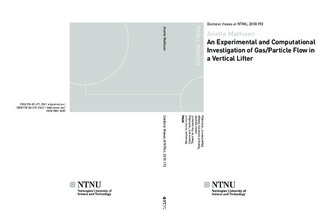| dc.description.abstract | Experimental and computational investigations of dilute gas/particle flow in a vertical lifter are performed. The effect of superficial gas velocity, particle density, particle size distribution and particle loading on particle velocities, particle fluctuations and particle cross-moment have been studied experimentally using laser Doppler anemometry (LDA) and particle image velocimetry (PIV). The results from the experimental investigation is compared with the computational investigation using FluentR.
The experimental measurements are performed on a lab-scale vertical lifter, consisting of a fluidizing silo and a receiving tank with a glass pipe in which the solids phase is transported. The particles are placed in the fluidization tank and transport air enters at the bottom of the silo. The transport pipe is suspended above the inlet and as the transport air passes the opening, the particles are dragged into the air flow and transported upwards to the receiving tank. Fluidizing air is used to control the particle loading in the system and supplied through a distribution plate. The test section of the transport pipe is made of glass to enable the use of the optical laser based investigation techniques, LDA and PIV. Two types of powders are used, ZrO2 and glass, each with two different particle size distributions, average diameter of 260 and 530 micron and 120 and 518 micron, respectively.
The experimental techniques LDA and PIV are used to investigate a dilute gas/particle vertical flow. The two techniques are also evaluated for use on this type of flow. LDA is a single point measurement technique, which means that one point is measured at a time. The acquisition stops when a pre-set criteria is reached, this can either be based on sample number or time. A measurement spanning over the whole cross-section of the pipe consists of several points. These points makes up a cross-sectional profile. PIV on the other hand is a whole field technique and consequently the whole cross-section of the pipe is measured simultaneously. Within a given time interval two laser pulses light up the flow and the reflection of the particles is captured by a camera.
Satisfactory measurements of all the particle types are performed using LDA. The mean axial and normal particle velocities and fluctuations as well as the cross-moment, are measured at varying particle volume fraction and superficial gas velocity. The value of the measured quantities will vary depending on the particle size, particle density, particle volume fraction and superficial gas velocity. A comparison between the particle types show that the mean axial particle velocity is highest for the lighter and smaller particles, but the fluctuations are greatest for the larger and heavier particles. For smaller particles LDA is a very efficient measurement tool. For the largest particles the acquisition can be time consuming due to relatively few particles in the system.
PIV measurements are generally performed satisfactory on all of the particle types. The exception is measurements performed on the smaller particles at the higher particle volume fractions. The mean axial and normal particle velocities and fluctuations including the crossmoments are measured at varying particle volume fraction and superficial gas velocity. The results from the measurements show that the measured quantities will vary depending on the particle size, particle density, particle volume fraction and superficial gas velocity. When comparing the particle types, it is observed that the mean axial particle velocity is highest for the smaller and lighter particles while the fluctuations are lower than for the larger and heavier ones. The combination of particles larger than commonly used tracer particles and higher particle volume fractions is challenging, but overall the PIV technique works well.
Comparison between LDA and PIV results show generally a good agreement for the mean axial particle velocity. The mean axial and normal particle fluctuations and the particle crossmoment are generally measured lower when using PIV.
Simulations are performed using FluentR and the model Euler-Euler, where both phases are regarded as being continua. The kinetic theory of granular flow (KTGF) is included for the solids phase. Initially only the single transport pipe is simulated in 2d and 3d. The flow in this pipe is dilute and therefore the simulations which included KTGF and the Gidaspow drag model are compared to simulations enabling the constant viscosity model (CVM) and the Schiller-Naumann drag model. The results from the simulations show very little difference between the two simulations. Euler-Euler with KTGF 2d and 3d simulations are performed for all of the particle types. Little difference between 2d and 3d simulations are observed. A comparison between simulations and experimental results, LDA and PIV, showed good agreement for axial particle velocity for all of the particle types. The upward transport of particles in a vertical pipe is also simulated using Euler-Lagrange. Here a number of particles are tracked and compared to the experiments with good agreement.
Simulations of the vertical lifter, a silo containing the particles and a transport pipe, show that simulations using Euler-Euler including KTGF and the Gidaspow drag model over-predicted the particle volume fraction in the pipe compared to the experiments. The reason for this discrepancy is that the experimental set-up is modified to give low particle volume fractions in the transport pipe to enable the use of lasers to investigate the flow. | nb_NO |

